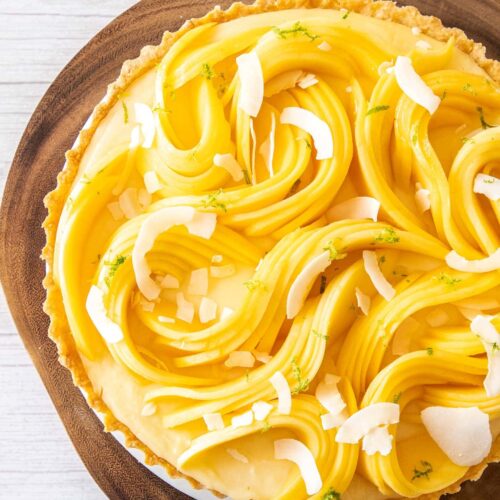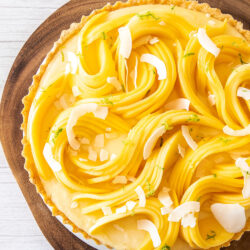If it’s a tropical dessert you’re looking for, then this mango tart is a sure thing. I mean isn’t she beautiful?!
The pastry base is buttery, crisp and the perfect contrasting texture to the soft custard filling. The mango in this dessert is all in the form of fresh mango slices arranged over the top of the tart after the custard sets.
This beautiful tart is just 3 layers of easy, homemade deliciousness and you’d be surprised how simple it really is.
The new year hits and all I can think of is bright, fresh, tropical desserts. This homemade mango curd is a favourite around here as is this mango coconut cheesecake and my mango pavlova.
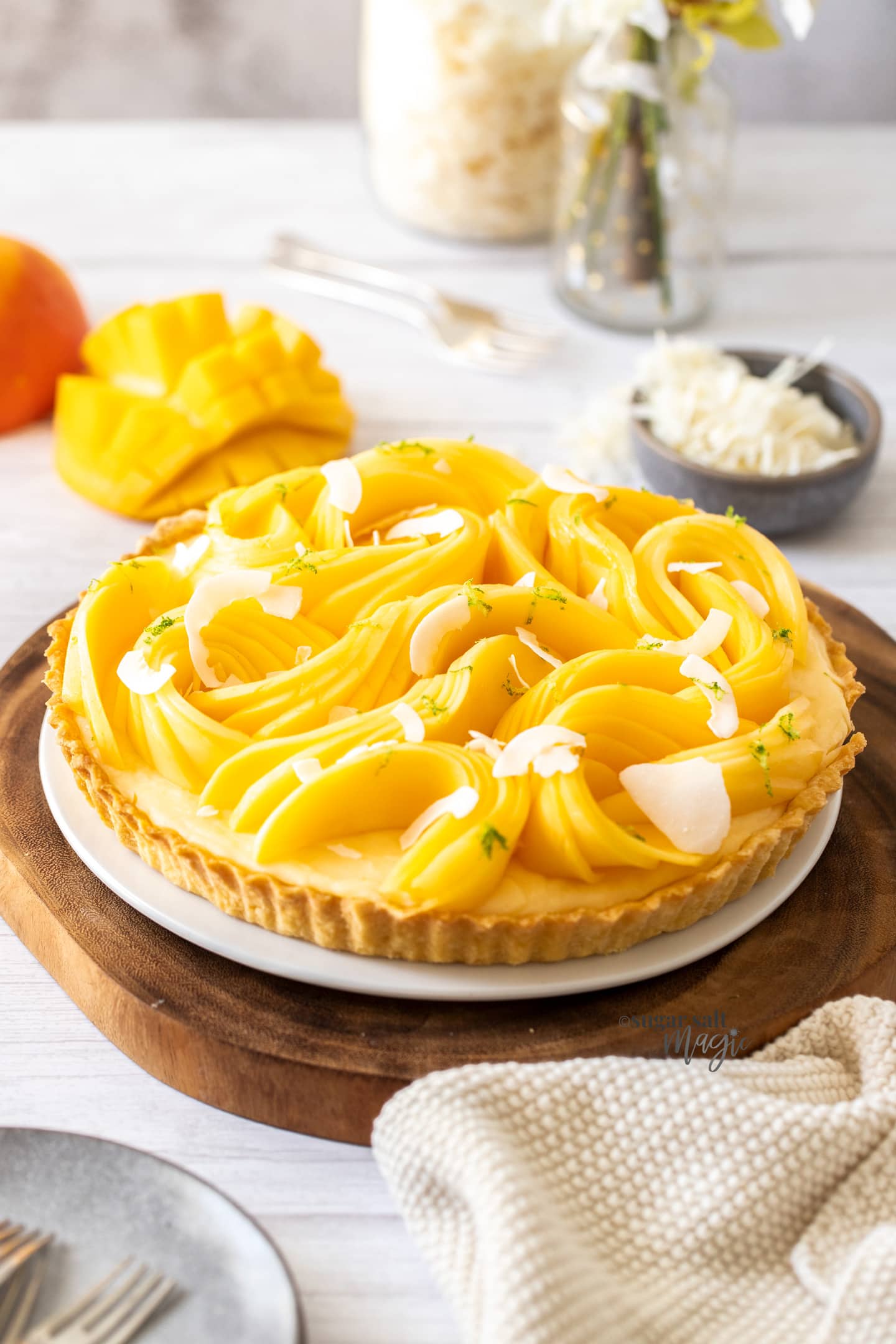
Never Miss a Recipe!
Get the latest recipes straight to your inbox!
What you’ll need
You probably have everything you need for this tart on hand, except maybe the mangoes.
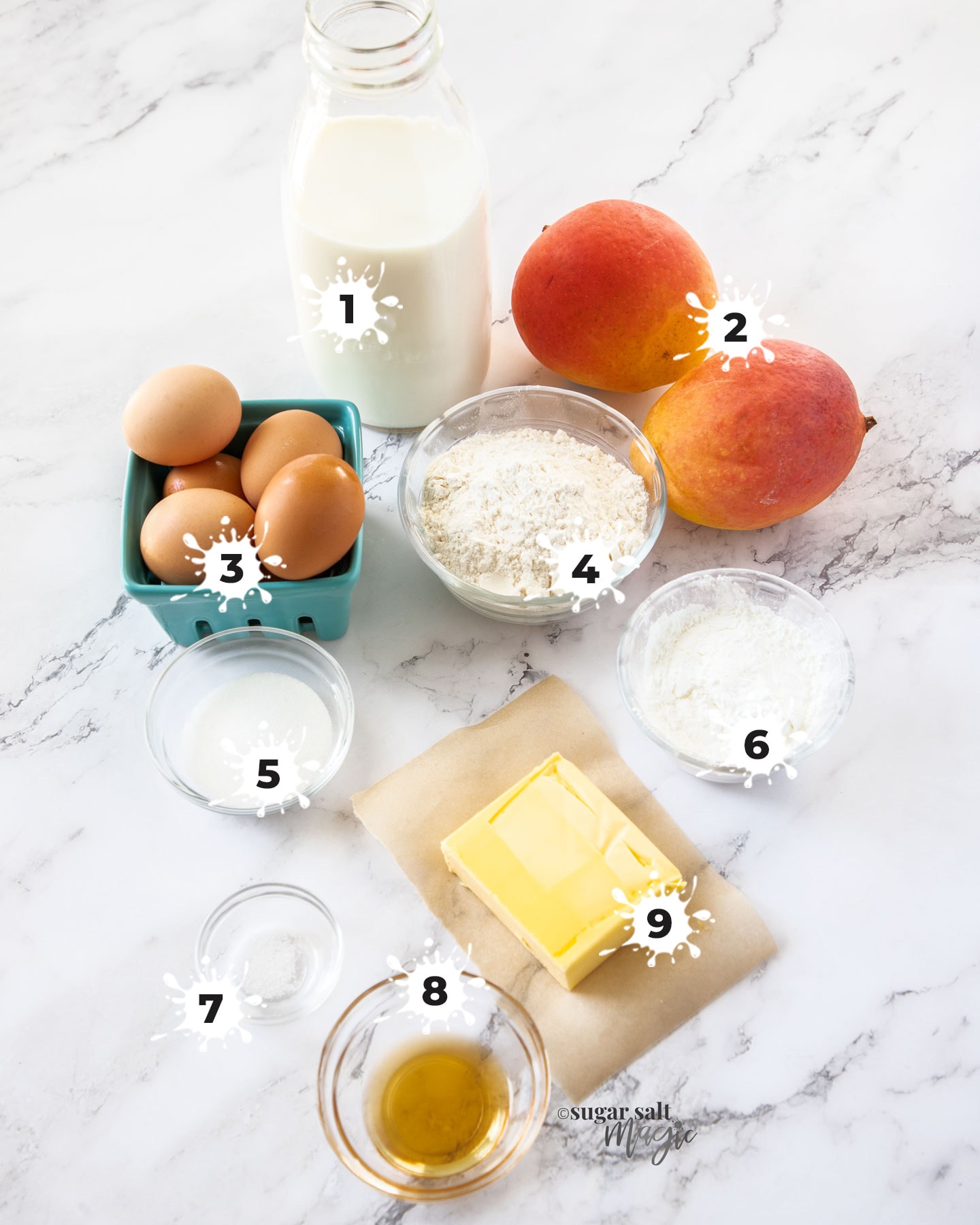
Detailed instructions in the recipe card below.
- Mangoes: Make sure the mangoes are ripe. You can check by smelling the end where the stalk is – it should have a strong mango smell and the mango should not be hard.
- Milk: It’s best to use whole milk for the custard for flavour, however light milk or even non-dairy milks will work.
- Eggs: These will help thicken the custard and give it it’s rich flavour.
- Cornflour (cornstarch): This is used to thicken and help set the custard.
Butter, flour, sugar, salt and vanilla round out the group of ingredients.
What is pâté sucrée?
Pâté sucrée is the French term for a particular style of sweet shortcrust pastry. This pastry is almost cookie-like in texture and slightly sweet. It’s also incredibly delicious and can literally be made into cookies.
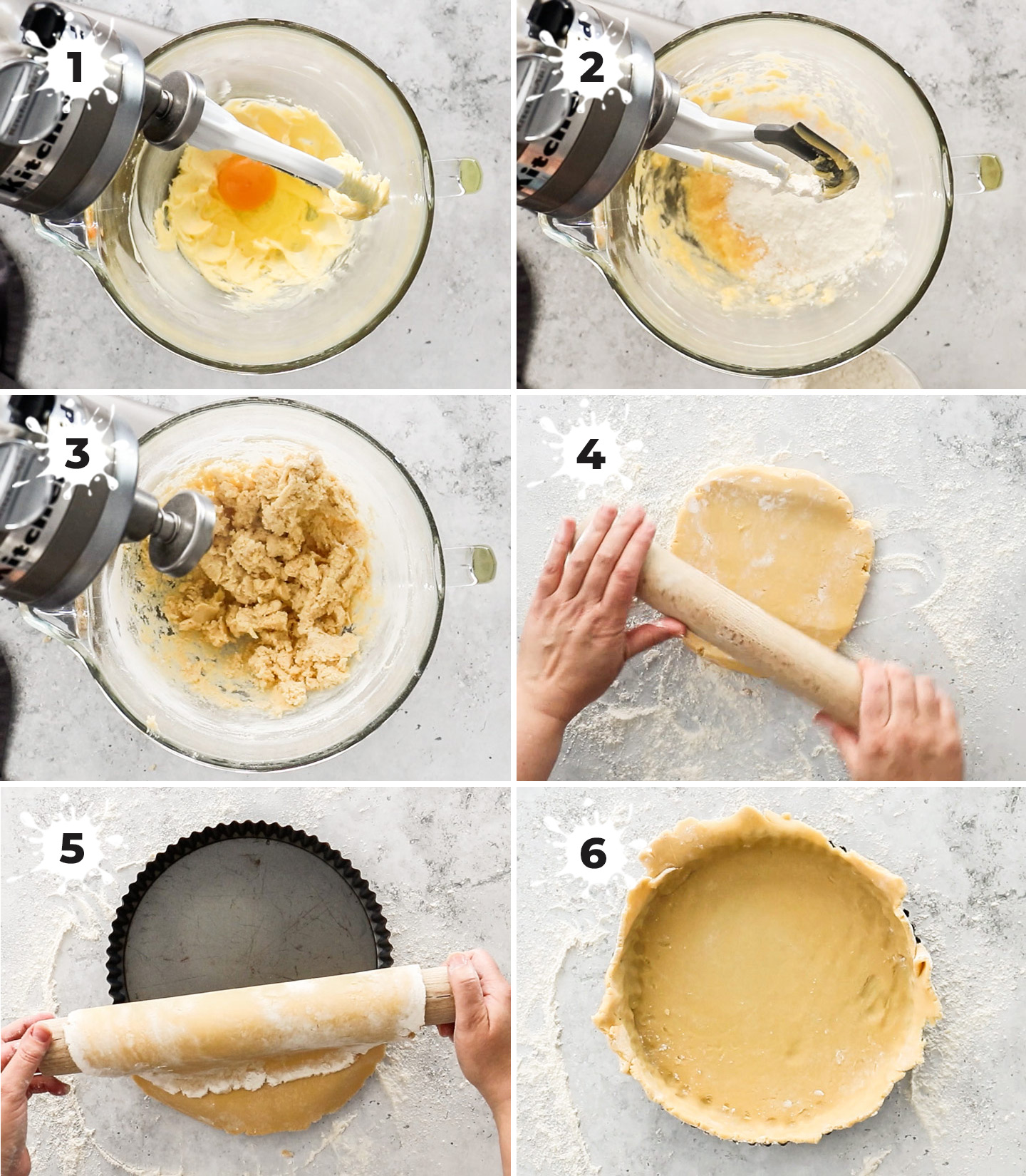
Detailed instructions in the recipe card below.
- Make the pastry: Start by beating together butter and sugar, then add the egg (photo 1) and beat to combine. Add the flour (photo 2) and beat through until combined and beginning to clump together (photo 3).
- Make the tart shell: Shape the dough into a smooth dish and roll it out immediately (photo 4) on a lightly floured surface then lay it into your tart tin (photo 5). Press it down into the corners gently with your fingertips and leave the edges standing up (photo 6). Chill the tart shell for at least 2 hours.
- Bake the tart shell: Prick the base of the tart shell with a fork all over, then trim off the overhanging pastry. Line the shell with baking paper. Fill the paper with pie weights or rice to weigh it down and bake for 20 minutes followed by another 15 minutes with the baking weights removed.
The custard filling
The custard filling is essentially crème patissiere (pastry cream) and you’ll be surprised how easy it is to make.
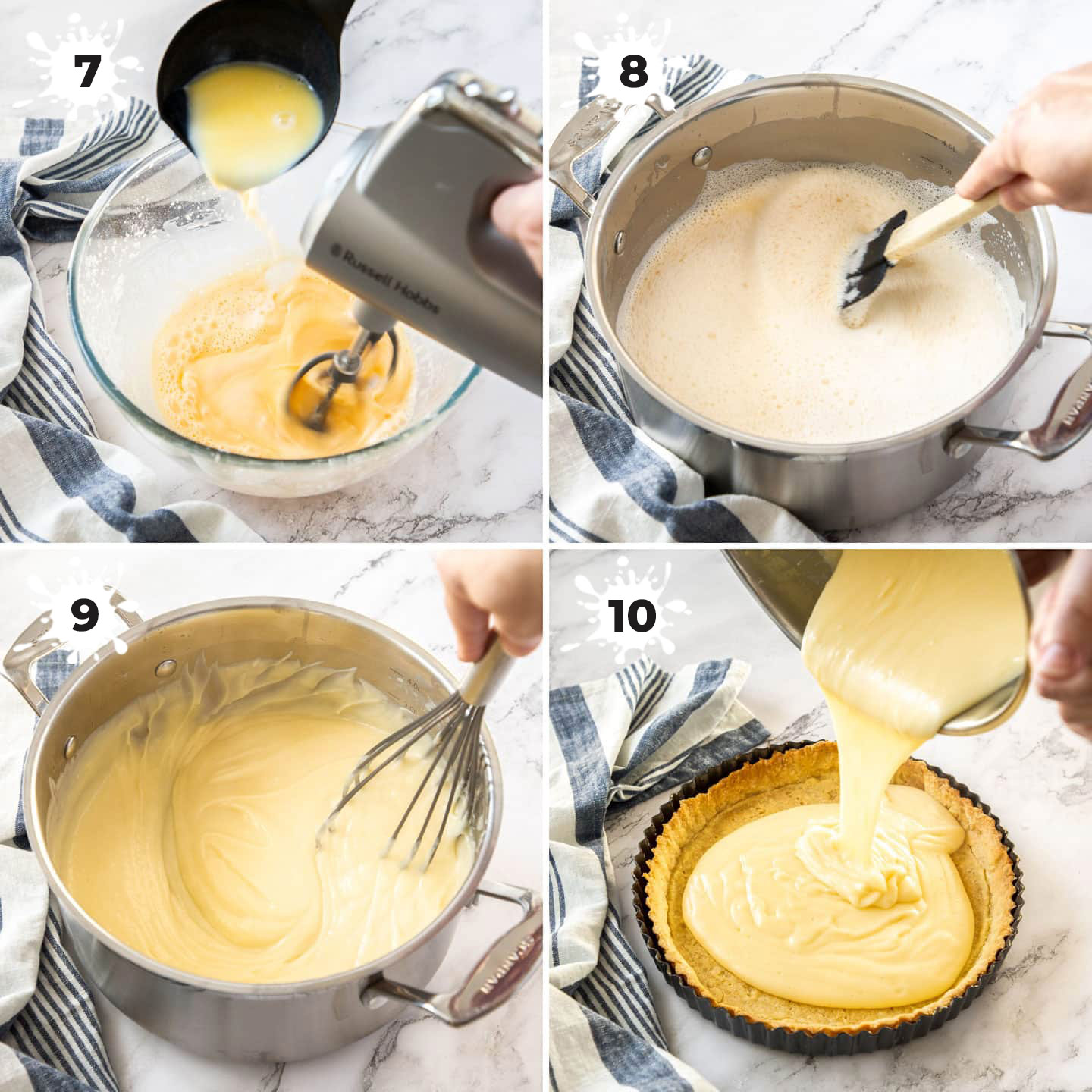
- You’ll start by heating some milk, sugar, butter and vanilla until steaming.
- In a bowl, you’ll beat together eggs and cornflour (cornstarch) until pale, then very slowly drizzle in the hot milk whilst still mixing (image 7).
- Pour it all back into the saucepan (image 8) and then stir constantly over low heat with a whisk until it’s very thick (image 9).
- This gets poured straight into the tart shell (image 10) and then chilled until completely set.
You can also fill this tart with this Mango Mousse.
The mango decoration
The mango in this mango tart, comes in the form of loads of sliced fresh mangoes on top. You need two large mangoes for this.
- Peel the mangos: First peel the mangoes just using a regular vegetable peeler. Be careful as they do get slippery.
- Slice the mangoes: Cut the cheeks off, either side of the stone, then lay them flat side down on a chopping board. Cut them into lots of very thin slices.
- Arrange the mango slices: You may notice as you try move the mango slices around, they will slide against each other and straight away you’ll see how the decoration on top is achieved. Slide groups of 5-6 slices against each other, then curve them and place them randomly all over the top of the tart.
You can serve the tart as soon as the custard has cooled, or let it chill for 1-2 days. The longer it sits though, the drier the mango will start to look, so the fresher it is served, the better.
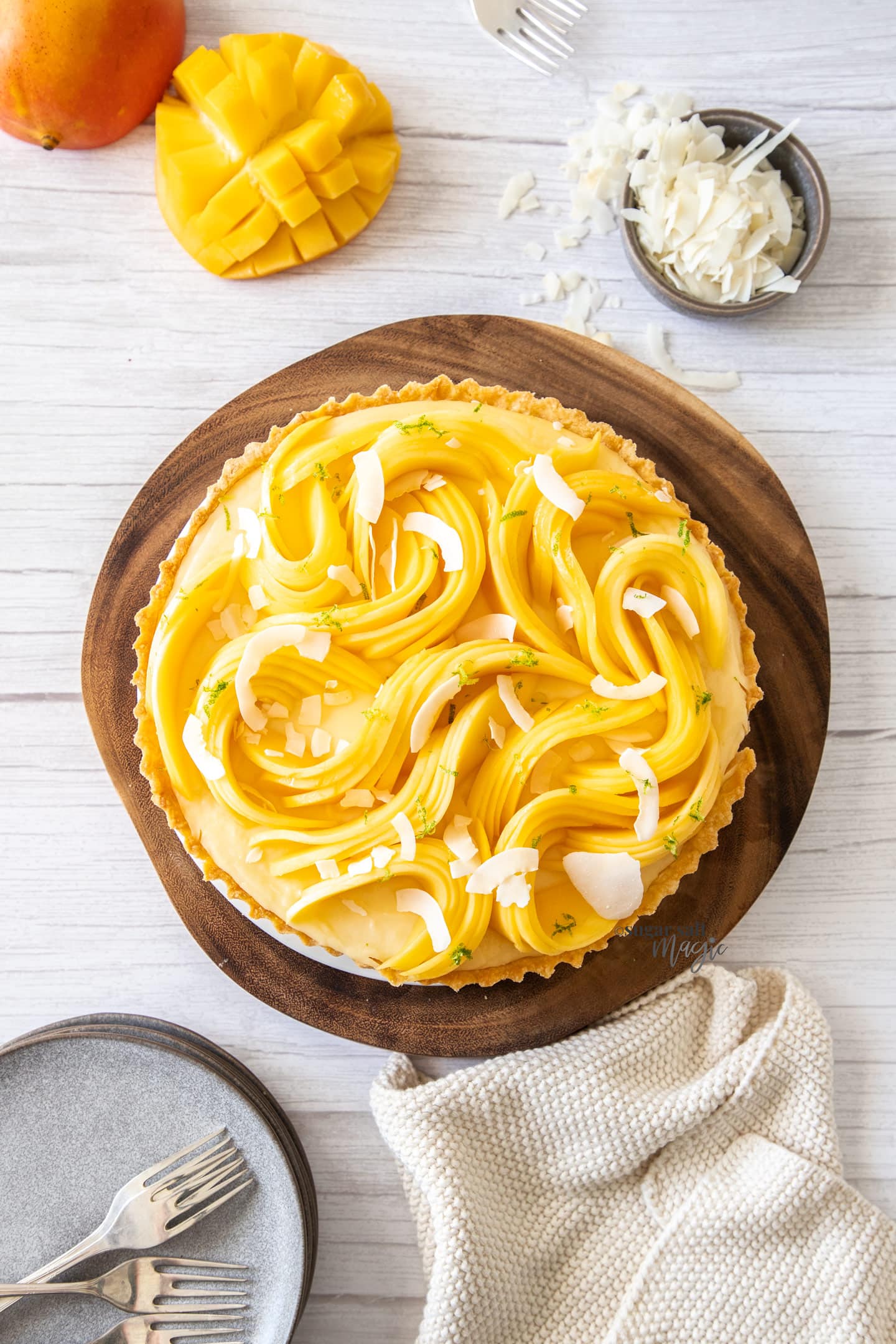
Tips and tricks
- Don’t boil the milk: You just want the milk mixture to be hot enough that it’s steaming.
- Add the milk slowly: Make sure just to drizzle the milk into the eggs slowly at the same time as you’re whisking otherwise you may end up with scrambled eggs.
- Let the filling set before topping and serving. It needs to set so that it’s firm enough to hold the weight of the mangoes.
Can I make mango tart ahead
Mango tart is best served fresh, however, as long as you store it in an airtight container in the fridge, it should keep well for 1-2 days before the mangoes start looking a little worse for wear.
You can make the pastry dough ahead of time and store it in the freezer for up to 2 months, wrapped well in plastic wrap. You can also make and bake the tart shell and store it in the freezer for 1-2 months.
The custard filling can be made 2-3 days ahead, just make sure to give it a good whisk up so that it’s smooth before adding it to the tart shell.
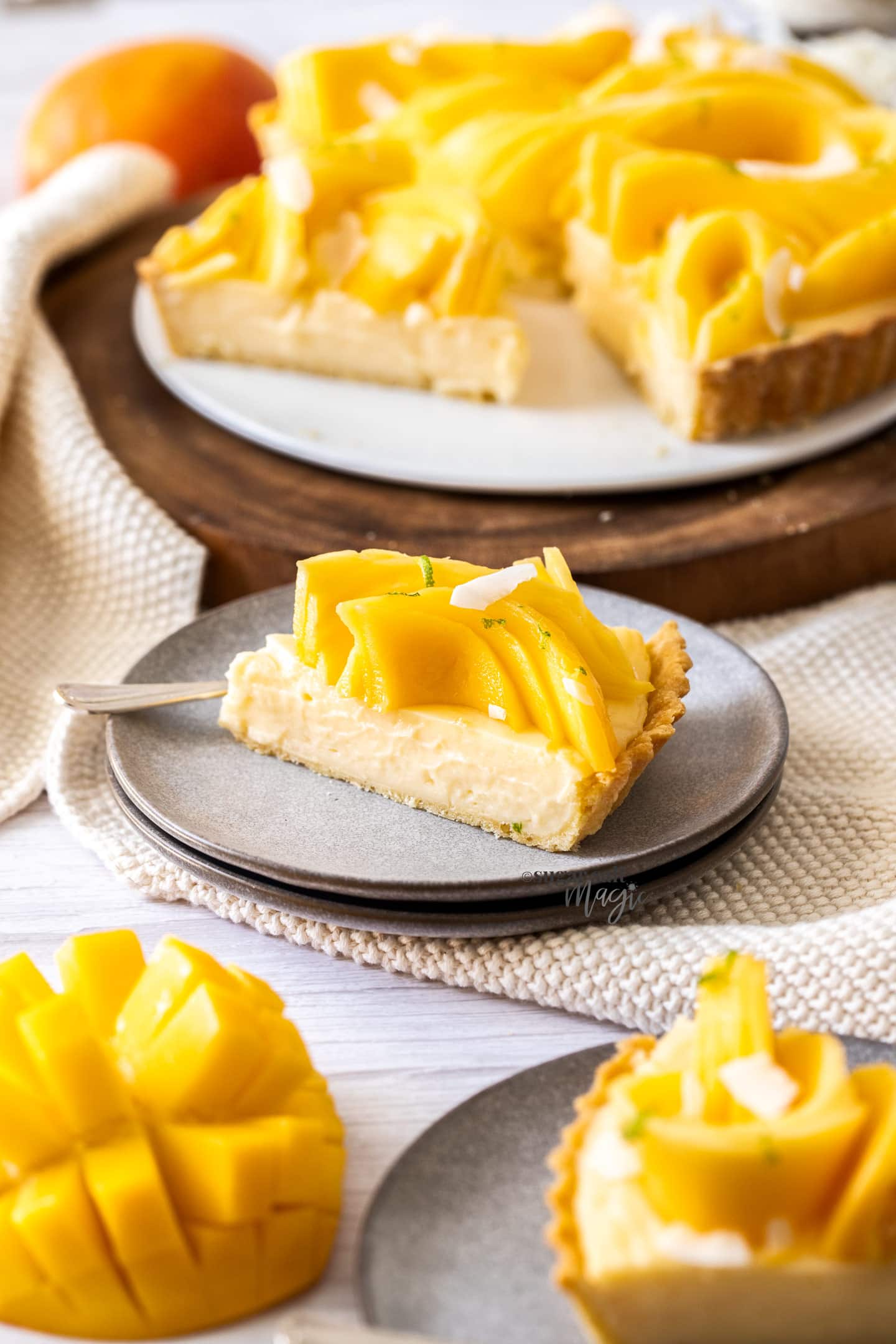
If you’ve tried this mango tart, make sure to leave a comment and star rating below.
Hungry for more? Subscribe to the newsletter for free recipes straight to your inbox. Also, follow along on Facebook, Pinterest and Instagram.
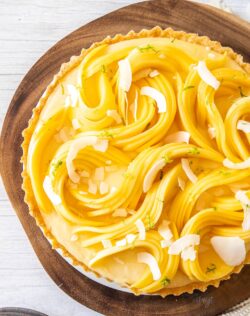
Ingredients
FOR THE TART SHELL
- 100 g unsalted butter, softened (7 tablespoons / 3.5oz)
- 40 g icing sugar (powdered sugar) (⅓ cup / 1.4oz)
- 1 large egg, room temperature
- 225 g plain flour (all purp flour) (1 ¾ cups / 8oz)
FOR THE FILLING AND TOPPING
- 3 ½ cups milk (875ml / 29.5 fl oz)
- 57 g butter
- 3 teaspoons vanilla extract
- 100 g granulated white sugar (1/2 cup / 3.5oz)
- ½ cup cornflour (cornstarch)
- 2 large eggs
- 3 egg yolks, from large eggs
- 2 mangoes, thinly sliced
For best results, always weigh ingredients where a weight is provided
Equipment
- stand mixer is helpful
- 9 inch fluted tart tin with removable base
- pie weights (or rice or dried beans)
Instructions
For the tart shell:
- In the bowl of a stand mixer with paddle attachment, add the butter and icing sugar. Beat on medium until fully combined and smooth (1 – 2 minutes).
- Add the egg and beat on low until smooth. Add the flour and beat just until large clumps are forming.
- Turn the dough out and pull it together into a smooth ball with your hands (making sure not to handle it too much) then press it out into a 1 inch thick disk.
- Place it onto a lightly floured work surface and dust the top with just a little flour too. Gently and gradually roll the pastry out, turning it often, to about 4-5mm thick or about 11 inches in diameter.
- Place the rolling pin in the middle of the dough and fold one side of the pastry over the top. Lift the rolling pin so the pastry is hanging over it, and lightly dust off any excess flour from underneath. Carefully lay it into a 9 inch round tart pan with removeable base.
- Press the dough down in to the corners all the way round with your fingertips, then press it into the scalloped sides. Leave the overhang standing upright and place the tart pan into the fridge to chill for a minimum of 2 hours or overnight. If your freezer has space you can place it in there.
- BAKE THE TART SHELL:Preheat the oven to 180C (160C fan) / 350F.
- Trim the overhang off the pastry with a sharp knife laid flat along the top of the tart tin and prick the base of the pastry shell all over with a fork.
- Lay a sheet of baking paper into the shell and fill with rice (or pie weights), nudging them into the corners.
- Transfer to the preheated oven and bake for 20 minutes then remove the baking paper and rice and bake a further 15-20 minutes. If the edges are browning too much, cover them with foil. It's done when the base is starting to colour and the edges look a pale golden brown.
FOR THE FILLING
- Pour the milk into a heavy based saucepan, and add the butter, sugar and vanilla, then heat on very low heat until steaming, stirring regularly.
- While the milk mixture is heating, whisk together the cornflour, egg and egg yolks until pale yellow.
- Once the milk mixture is steaming, drizzle it slowly into the eggs while whisking constantly. Don’t pour it too quickly or the heat will scramble the eggs.
- Return the entire mix to the saucepan. Heat over low heat, stirring with a balloon whisk constantly, until it gets very thick. This will happen quite suddenly after about 5 minutes, so it’s important to keep stirring so you don't get lumpy custard.
- The custard is thick enough, when it takes 4-5 seconds to return to the side of the pan and the whisk leaves a trail.
- Remove from the heat and allow to cool for a couple of minutes before pouring into your tart shell. Level out the top with an offset spatula or knife.
- Place in the fridge and allow it to set for about 1 hour before topping and serving.
- Peel the mangoes, then use a sharp knife to cut off the cheeks running along the side of the stone. Place them flat side down on a board, then cut thin slices. Using groups of 4-5 slices, arrange them over the top of the tart.
- Please take a moment to leave a comment & rating. It's appreciated and so helpful.
Notes
- Tablespoons: I use a standard Australian 20ml tablespoon (4 teaspoons worldwide)
- For best results you should always weigh ingredients like flour and sugar. Kitchen scales like these are relatively cheap but if you can’t weigh the ingredients, use the spoon and level method (don’t scoop).
More Information
These links will take you up to the post – just scroll down to get back to the recipe card.- What is pâté sucrée? Step by step photos
- The custard filling. Step by step photos
- The mango decoration
- Tips and tricks
- Can I make mango tart ahead
MORE PIES AND TARTS!
This post may contain affiliate links that earn me a small commission for my referral, at no extra cost to you. Thank you for supporting Sugar Salt Magic.

